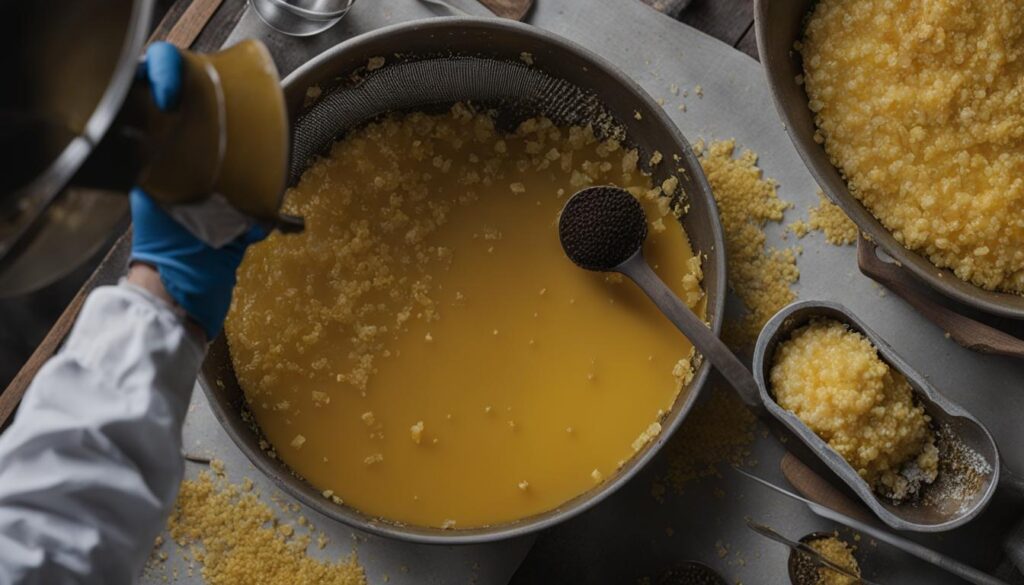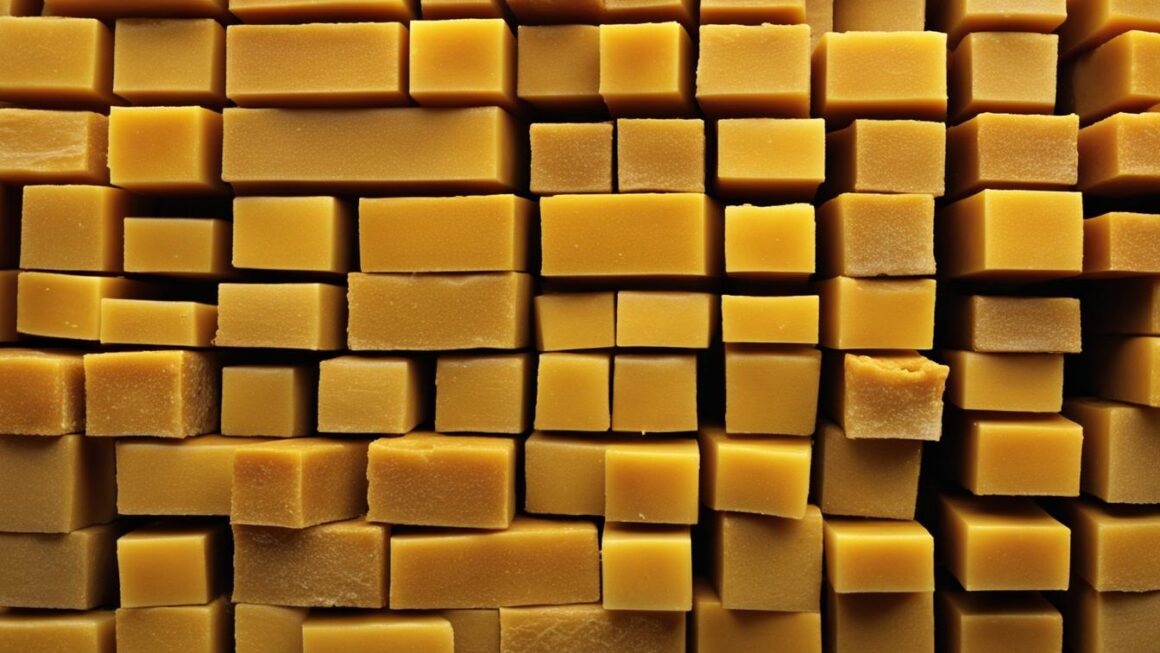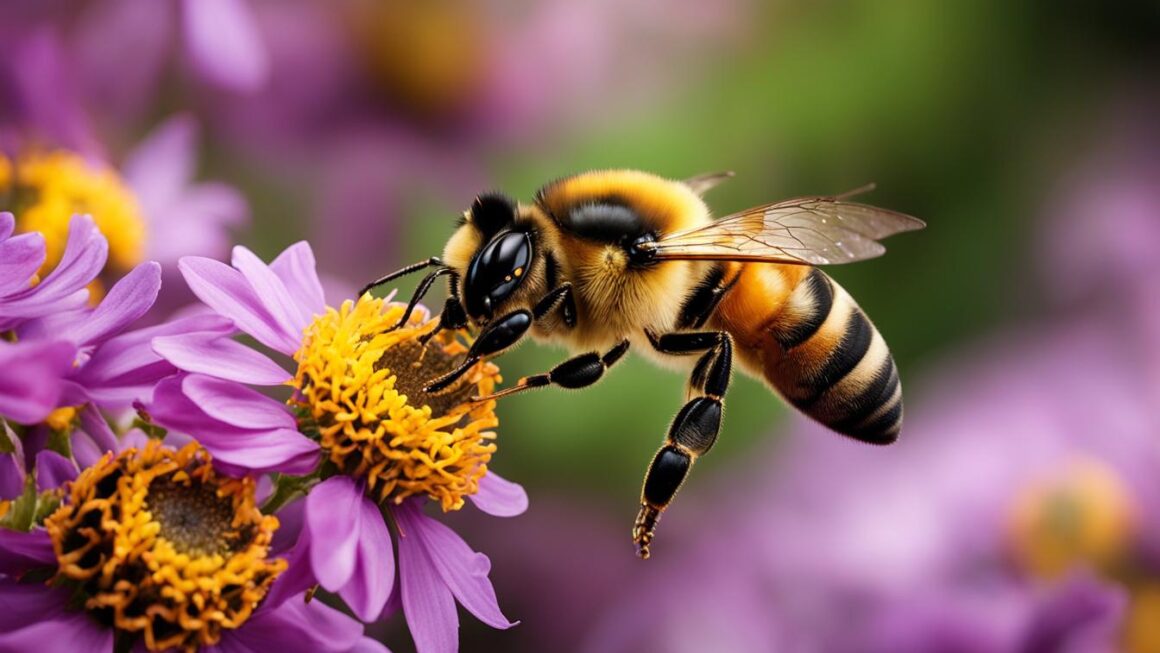Harvesting beeswax is a crucial process in beekeeping, requiring specific techniques to ensure optimal extraction. With the right approach, beekeepers can collect and extract high-quality beeswax for various uses. In this section, we will explore the essential techniques involved in harvesting beeswax, from the best time to harvest to the tools and equipment needed for a successful extraction.
Key Takeaways:
- Harvesting beeswax involves several essential techniques for optimal extraction.
- The best time to harvest beeswax is when there are fewer bees around the hive.
- Beekeepers should wear protective gear, including a full beekeeper’s outfit.
- Using a smoker can help calm the bees during the harvesting process.
- Frames with wax caps should be carefully removed to avoid damaging the hive or injuring the bees.
Best Time to Harvest Beeswax
When it comes to harvesting beeswax, timing is crucial. The best time to harvest beeswax is during the hours when the majority of bees are out foraging for pollen. Typically, this occurs between 9:00 am and 4:00 pm. During this time, there are fewer bees present inside the hive, making it easier to access the frames and extract the wax caps.
Harvesting beeswax during the recommended time period not only ensures a smoother extraction process but also reduces the risk of getting stung. With fewer bees present, there is less chance of disturbing the hive and provoking defensive behavior from the bees. This makes the harvesting process safer and more efficient for both the beekeeper and the bees.
By choosing the right time to harvest beeswax, beekeepers can optimize their extraction techniques and minimize any potential disruption to the colony. It is important to stay aware of the daily patterns and behavior of the bees to determine the most suitable time for harvesting. Ultimately, harvesting beeswax during the optimal time helps to maintain a harmonious relationship between beekeepers and their bees.
Beekeeper’s Protective Gear
When it comes to harvesting beeswax, wearing the right protective gear is essential to ensure the safety of the beekeeper. A full beekeeper’s outfit provides maximum protection and minimizes the risk of getting stung during the harvesting process. The outfit includes a suit, veil, gloves, and pants to cover all exposed areas. This gear acts as a barrier between the beekeeper and the bees, reducing the chances of bee stings and potential allergic reactions.
The beekeeper’s suit is typically made of a lightweight, breathable fabric that is resistant to bee stings. The veil helps protect the face and neck, while the gloves shield the hands and arms. The pants are designed to fit over the boots, ensuring complete coverage. It is important to ensure that the protective gear fits well and has no gaps or openings where bees can enter.
Wearing a beekeeper’s outfit not only protects the beekeeper but also helps maintain a calm and stress-free environment for the bees during the harvesting process. When the beekeeper feels safe and secure, they can focus on their work without the fear of getting stung, resulting in a more efficient and successful beeswax extraction.
Having the right protective gear is a crucial aspect of beekeeping, especially during beeswax harvesting. It ensures the safety of the beekeeper and helps create a harmonious relationship between the beekeeper and the bees.
| Protective Gear | Description |
|---|---|
| Beekeeper’s suit | A lightweight, breathable fabric that covers the entire body and provides resistance to bee stings. |
| Veil | A mesh fabric that protects the face and neck from bee stings while allowing for clear visibility. |
| Gloves | Durable gloves that cover the hands and arms to prevent bee stings. |
| Pants | Pants that fit over the boots and provide complete coverage, ensuring no exposed areas. |
Investing in a high-quality beekeeper’s outfit is a wise decision for any beekeeper involved in beeswax harvesting. It not only protects the beekeeper from potential harm but also promotes a positive and respectful relationship with the bees.
Using a Smoker for Beeswax Harvesting
Using a smoker is an essential method for calming bees during the beeswax harvesting process. The smoke emitted from the smoker creates an environment that makes the bees move lower in the hive, allowing for easier access to the frames and wax caps. By puffing smoke at the entrance of the hive, the bees perceive a fire and start consuming honey, which makes them less likely to bother the beekeeper during the harvesting process.
The use of a smoker helps to reduce the risk of bee stings and makes the bees more cooperative during the extraction of beeswax. It is important to ensure that the smoker is lit properly using materials such as dried leaves or pine needles. The smoke should be directed towards the hive entrance and gaps between the frames to create a calming effect on the bees.
When using a smoker, it is crucial to maintain a balance between producing enough smoke to calm the bees and avoiding excessive smoke that may harm the bees or contaminate the beeswax. The smoker can be periodically puffed at the entrance of the hive to maintain the calmness of the bees throughout the harvesting process. By using a smoker effectively, beekeepers can ensure a smooth and safe beeswax extraction process.
“The use of a smoker is a tried and tested method in beekeeping. The smoke helps to relax the bees, making it easier to access the frames and collect beeswax. It’s important to handle the smoker with care and practice proper smoking techniques to ensure the happiness and well-being of the bees.” – Experienced Beekeeper
Removing Frames with Wax Caps
Once the bees have been calmed with smoke, it is time to carefully remove the frames containing the wax caps. These frames are filled with honeycomb and wax caps, representing the hard work of the bees. The removal process requires gentle handling to prevent any damage to the hive or harm to the bees.
Using a hive tool, the beekeeper can gently pry open the frames and lift them out of the hive. It is essential to inspect each frame for any bees that may still be attached. If any bees are present, a bee brush can be used to gently brush them off the frame without causing harm. This step ensures that the bees can return safely to the hive once the harvesting process is complete.
Removing the frames with wax caps is a crucial step in beeswax production. These frames, filled with honeycomb and wax caps, contain the precious beeswax that will be extracted and processed later. The careful removal of these frames ensures that the harvest is successful and that the bees can continue their vital work within the hive.
| Key Takeaways |
|---|
| Removing frames with wax caps is an important step in beeswax production. |
| Frames should be carefully lifted out of the hive using a hive tool. |
| Inspect each frame for attached bees and gently remove them using a bee brush. |
| Proper removal ensures the beeswax harvest is successful and minimizes any harm to the bees or the hive. |
Scrape Wax Cappings Using an Uncapping Knife
One of the essential steps in beeswax processing is the use of an uncapping knife to scrape off the wax cappings from the honeycomb frames. The uncapping knife is a specialized tool with a hot, sharp blade that effortlessly removes the wax caps, allowing for the extraction of pure beeswax.
Using an uncapping knife is a delicate process that requires precision and careful handling. The beekeeper runs the blade of the knife in one steady motion across the wax caps, causing them to easily slide off the frame. This technique separates the beeswax from the honeycomb, allowing for its collection and further processing.
“The uncapping knife is an indispensable tool for beekeepers engaged in harvesting natural beeswax. Its hot blade efficiently removes the wax caps, ensuring the extraction of high-quality beeswax for various applications.”
If an uncapping knife is not readily available, a dull butter knife or a fork can be used as an alternative. However, it is important to note that these makeshift tools may not be as effective as an uncapping knife, and the process may require more effort and time.
By utilizing an uncapping knife during beeswax harvesting, beekeepers can ensure the efficient extraction of pure beeswax from the honeycomb frames, which can then be processed and utilized in various ways.

Table: Bee Losses During Beeswax Melting and Filtering Process
| Year | Number of Colonies | Colonies Lost |
|---|---|---|
| 2018 | 100 | 10 |
| 2019 | 120 | 12 |
| 2020 | 150 | 8 |
The table above shows the number of bee colonies and the corresponding colonies lost during the beeswax melting and filtering process for three consecutive years. It is crucial for beekeepers to monitor and minimize colony losses during this process to maintain healthy and thriving bee populations. Implementing proper techniques and equipment can greatly reduce stress on the bees and ensure the successful extraction of high-quality beeswax.
Cleaning Beeswax Residue
Cleaning beeswax residue can be a challenging task, but with the right techniques and tools, you can effectively remove beeswax stains from various surfaces. Whether it’s clothing, carpets, or furniture, here are some beeswax cleaning techniques that can help restore the affected areas to their original condition.
Freezing Method
If you’re dealing with beeswax residue on a solid surface like furniture or countertops, the freezing method can be highly effective. Simply place a bag of ice or an ice pack on the affected area to freeze the wax. Once the wax hardens, you can easily scrape it off with a dull knife or credit card. This method works best for larger chunks of wax and can be a quick way to remove stubborn residue.
Iron and Absorbent Paper
For beeswax stains on fabrics like clothing or tablecloths, the iron and absorbent paper method can help lift the wax off the material. Place a clean, absorbent paper towel or brown paper bag over the affected area. Then, gently run a warm iron over the paper, which will melt the wax and transfer it onto the absorbent material. Repeat this process with fresh paper until the wax is fully removed. Remember to work with caution and avoid overheating the fabric to prevent any damage.
Vinegar and Water Solution
If you’re dealing with a smaller beeswax stain on a washable fabric, you can try using a vinegar and water solution. Mix equal parts white vinegar and water, and dab the solution onto the stained area using a clean cloth or sponge. Let it sit for a few minutes to allow the vinegar to break down the wax. Then, gently blot the area with a clean cloth to lift the residue. Finally, rinse the fabric with water to remove any leftover vinegar solution.
Remember, it’s important to test any cleaning method on a small, inconspicuous area first to ensure it doesn’t cause any damage or discoloration. Additionally, always follow the manufacturer’s instructions for cleaning specific surfaces or fabrics. By using these beeswax cleaning techniques, you can effectively remove residue and enjoy the beauty of a clean and wax-free environment.
Storing Beeswax
Proper storage is crucial for maintaining the quality and integrity of beeswax. By taking the necessary precautions, beekeepers can ensure that their beeswax blocks remain in optimal condition for future use. Here are some guidelines for storing beeswax:
- Choose a cool and dry location: Beeswax should be stored in a cool environment with low humidity. Avoid areas that are exposed to direct sunlight or extreme temperatures, as they can cause the wax to melt or become too soft.
- Use appropriate containers: Plastic containers or bags are ideal for storing beeswax blocks. Make sure the containers are clean and tightly sealed to keep out dust, debris, and contaminants.
- Keep away from strong odors: Beeswax has a natural ability to absorb surrounding odors. It’s important to store it away from strong-smelling substances to prevent the wax from acquiring unwanted scents.
When storing beeswax, it’s essential to remember that beeswax has a low melting point, around 145°F (63°C). Therefore, it’s crucial to protect it from heat sources and high temperatures to avoid any deformation or loss of quality.
By following these storage guidelines, beekeepers can preserve beeswax for extended periods, ensuring its usability for various applications. Whether it’s for candle making, cosmetics, or other crafts, well-stored beeswax remains a valuable resource in beekeeping and beyond.
Conclusion
Harvesting beeswax is a crucial process in beekeeping that requires careful techniques and equipment for optimal extraction. By following the proper procedures, beekeepers can successfully separate beeswax from honeycomb, clean and filter it, and store it for future use. Throughout the harvesting process, it is important to prioritize sustainable practices to minimize the impact on bee colonies and the environment.
From choosing the best time to harvest and wearing protective gear, to using a smoker and removing frames with wax caps, each step plays a vital role in ensuring a successful beeswax extraction. The use of an uncapping knife to scrape the wax cappings, followed by collecting, melting, and filtering the beeswax, guarantees the production of pure and high-quality beeswax.
Once the beeswax is harvested, it is important to store it properly in a cool and dry place, away from extreme temperatures and direct sunlight. By implementing these techniques and practices, beekeepers can make the most of this versatile and valuable resource. Beeswax has a wide range of applications and benefits, making it sought after in various industries and for personal use.
FAQ
What is the best time to harvest beeswax?
The best time to harvest beeswax is between 9:00 am and 4:00 pm when there are fewer bees around the hive.
What protective gear should I wear when harvesting beeswax?
It is important to wear a full beekeeper’s outfit, including a suit, veil, gloves, and pants, to protect yourself from bee stings.
How does using a smoker help with beeswax harvesting?
Using a smoker calms the bees by making them move lower in the hive, allowing easier access to the frames and wax caps.
How do I remove frames with wax caps?
Frames with wax caps can be lifted using a hive tool and inspected for any attached bees, which can be gently removed using a bee brush.
What is an uncapping knife used for in beeswax harvesting?
An uncapping knife is used to scrape the wax cappings from the honeycomb frames to separate the beeswax from the honeycomb.
How do I collect and prepare beeswax caps?
Beeswax caps should be collected in a bucket, and the honey present in them will naturally separate from the wax when left to sit for 15-30 minutes.
What is the process of melting and filtering beeswax?
Beeswax can be melted using a double boiler and then strained through cheesecloth or a fine mesh to remove impurities.
How do I clean beeswax residue?
Beeswax residue can be cleaned using techniques such as melting and absorbing with an iron, freezing for easier removal, or using vinegar and water solutions.
How should I store beeswax?
Beeswax should be stored in a cool and dry place, preferably in plastic containers or bags, away from extreme temperatures or direct sunlight.




